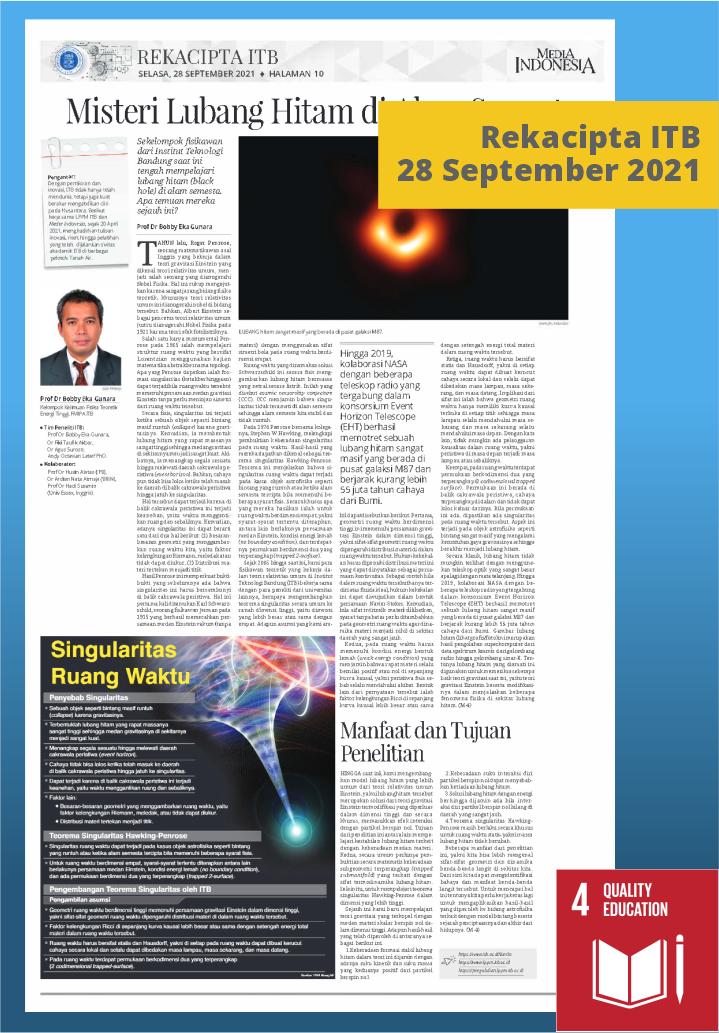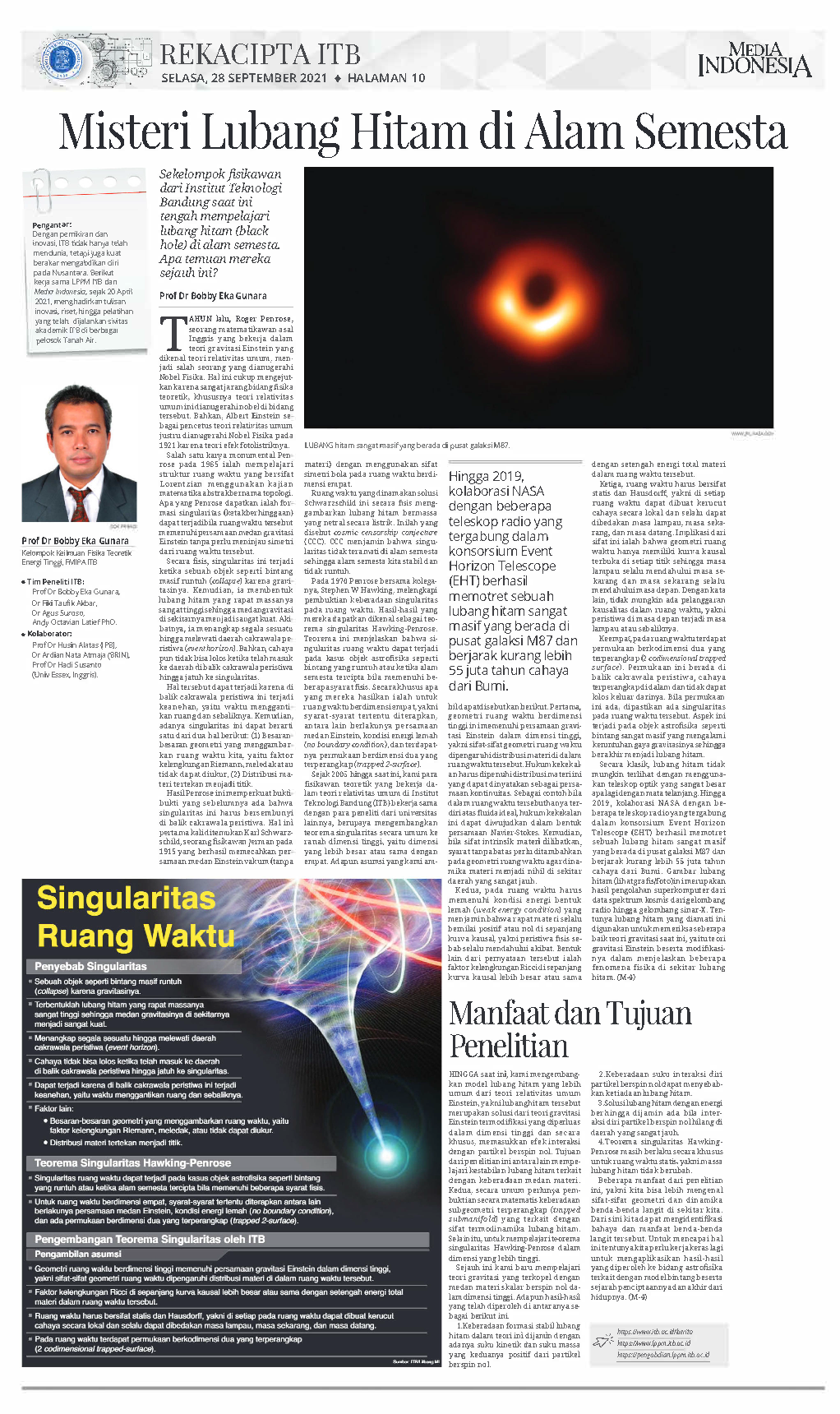

The Mystery of Black Holes in the Universe
Tags: ITB4People, Community Services, Pengabdian Masyarakat, SDGs4
Last year, Roger Penrose, a British mathematician who worked on Einstein's theory of gravity known as the general theory of relativity, was one of the recipients of the Nobel Prize in Physics. This is quite surprising because it is very rare for the field of theoretical physics, especially the general theory of relativity, to be awarded the Nobel Prize in that field. In fact, Albert Einstein as the originator of the general theory of relativity was awarded the Nobel Prize in Physics in 1921 for his theory of the photoelectric effect.
One of Penrose's monumental works in 1965 was studying the Lorentzian structure of space-time using an abstract mathematical study called topology. What Penrose found was that the formation of a singularity (infinity) could occur if the space-time satisfies Einstein's gravitational field equation without having to consider the symmetry of the space-time.
Physically, this singularity occurs when an object such as a massive star collapses due to its gravity. Then, it forms a black hole whose density is so high that the gravitational field around it becomes very strong. As a result, it captures everything warm past the event horizon region. In fact, even light cannot escape when it has entered the area in the event horizon until it falls into the singularity.
This can happen because behind this event horizon there is an oddity, namely time replaces space and vice versa. Then, the existence of this singularity can mean one of two things: (1) The geometric quantities that describe our spacetime, namely the Riemann curvature factor, explode or cannot be measured, (2) The distribution of matter is compressed into points.
Penrose's results reinforce previously available evidence that this singularity must hide in the batik event horizon. This was discovered by Karl Schwarzschild, a German physicist in 1915 who succeeded in solving the Einstein vacuum field equation (without matter) by using the spherical symmetry properties in four-dimensional space.
Space-time, called the Schwarzschild solution, physically describes an electrically neutral mass black hole. This is called the cosmic censorship conjecture (CCC). CCC ensures that singularities are not observed in the universe so that our universe is stable and does not collapse.
In 1970 Penrose and his colleague, Stephen W Hawking, completed the proof of the existence of singularities in spacetime. Their results are known as the Hawking-Penrose singularity theorem. This theorem explains that spacetime singularities can occur in the case of astrophysical objects such as collapsing stars or when the universe was created if certain physical conditions were met. In particular, what they produced was for a four-dimensional space-time, where certain conditions were applied, including the validity of the Einstein field equation, a weak energy condition (no boundary condition), and the presence of a trapped 2-dimensional surface.
Since 2005 until now, we theoretical physicists who work in general relativity theory at the Bandung Institute of Technology (ITB) in collaboration with researchers from other universities, have tried to develop the singularity theorem in general to the realm of high dimensions, namely dimensions greater than or equal to with four. There are also assumptions that we take can be mentioned below. First, this high-dimensional geometry of spacetime satisfies Einstein's equations of gravity in high dimensions, namely the geometrical properties of spacetime are affected by the distribution of matter in that spacetime. The law of conservation of matter must be satisfied with this distribution of matter, which can be expressed as a continuity equation. For example, if the spacetime consists only of an ideal fluid, this law of conservation can be expressed in the form of the Navier-Stokes equation. Then, when the intrinsic properties of matter are involved, an infinite condition needs to be added to the geometry of spacetime so that the dynamics of matter is nil around very distant regions.
Second, space-time must meet the weak energy condition, which ensures that the density of matter is always positive or zero along the causal curve, i.e. physical events, the cause always precedes the effect. Another form of the statement is that the Ried curvature factor along a causal curve is greater than or equal to half the total energy of matter in that spacetime.
Third, space-time must be static and Hausdorff, i.e. in each space-time a light cone can be made locally and always distinguishable past, present, and future. The implication of this property is that the geometry of spacetime has only an open causal curve at each point so that the past always precedes the present and the present always precedes the future. In other words, there can be no violation of causality in space-time, i.e. future events occurring in the past or vice versa.
Fourth, in space-time there is a trapped two-dimensional co-dimensional surface. This surface is beyond the event horizon, light is trapped within and cannot escape from it. If this surface exists, it is certain that there is a singularity in that space-time. This aspect occurs in astrophysical objects such as very massive stars that experience the collapse of their gravitational force so that they end up becoming black holes.
Classically, black holes are impossible to see using very large optical telescopes, let alone the naked eye. Until 2019, NASA's collaboration with several radio telescopes belonging to the Event Horizon Telescope (EHT) consortium managed to photograph a terrifyingly massive black hole at the center of galaxy M87 and is approximately 55 million light years from Earth. This black hole image (see graphic/photo) is the result of supercomputer processing of cosmic spectrum data from radio waves to X-ray waves. Of course, the observed black hole is used to check how well the current theory of gravity, namely Einstein's theory of gravity and its modifications, explains some of the physical phenomena around black holes. (M-4).
Benefits and Research Objectives
TO date, we have developed a more general model of black holes than Einstein's general theory of relativity, in that they are solutions to Einstein's modified theory of gravity that are extended in high dimensions and specifically include the effects of interactions with zero-spinning particles. The purpose of this research is to study the stability of black holes related to the existence of a material field. Second, there is a general need to prove mathematically the existence of a trapped sub-geometry related to the thermodynamic properties of black holes. In addition, to study the Hawking-Penrose singularity theorem in higher dimensions.
So far we have only studied the theory of gravity coupled with a zero-spin scalar matter field in high dimensions. Some of the results that have been obtained include the following.
1. The existence of a stable formation of black holes in this theory is guaranteed by the existence of the kinetic term and mass term which are both positive of the zero spin particle.
2. The existence of the self-interaction term of the zero spin particle can lead to the absence of a black hole.
3. A black hole solution with finite energy is guaranteed to exist if the self-interaction of the zero-spinning particle is lost in a very distant region.
4. The Hawking-Penrose singularity theorem still applies specifically to static spacetime, i.e. the mass of a black hole does not change.
Some of the benefits of this research are that we can get to know more about the geometry and dynamics of the celestial bodies around us. From here we can identify the dangers and benefits of these celestial bodies. To achieve this, of course, we need to work hard again to apply the results obtained to the field of astrophysics related to the star model along with the history of its creation and the end of its life. (M-4).

